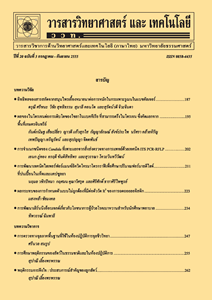ปัจจัยทำนายระดับการเฝ้าระวังและป้องกันภาวะเลือดออกในสมองของผู้ป่วยบาดเจ็บศีรษะเล็กน้อย โรงพยาบาลธรรมศาสตร์เฉลิมพระเกียรติ
Main Article Content
Abstract
บทคัดย่อ
การวิจัยครั้งนี้เป็นการวิจัยเพื่อหาปัจจัยที่เป็นตัวทำนายระดับการเฝ้าระวังอาการเลือดออกในสมอง และหาความสัมพันธ์ระหว่างปัจจัยทำนายกับระดับการเฝ้าระวังอาการเลือดออกในสมองของผู้ป่วยบาดเจ็บศีรษะเล็กน้อย กลุ่มตัวอย่างเป็นผู้ป่วยบาดเจ็บศีรษะเล็กน้อย จำนวน 100 ราย ที่เข้ารับการรักษาในโรงพยาบาลภายใน 48 ชั่วโมง ที่โรงพยาบาลธรรมศาสตร์เฉลิมพระเกียรติ จังหวัดปทุมธานี ในระหว่างเดือนกันยายน-ธันวาคม พ.ศ. 2557 เลือกกลุ่มตัวอย่างแบบเฉพาะเจาะจง ดำเนินการเก็บรวบรวมข้อมูลโดยใช้แบบสอบถาม ซึ่งผ่านการตรวจสอบความตรงด้านเนื้อหาและความเที่ยง เท่ากับ 0.71 สถิติที่ใช้ คือ สถิติเชิงพรรณนา และสถิติค่าสัมประสิทธิ์สหสัมพันธ์ ผลการวิจัยพบว่ากลุ่มตัวอย่างส่วนใหญ่เป็นเพศชาย (74.0 %) อายุระหว่าง 15-40 ปี (59.0 %) มีปัจจัยที่เป็นตัวทำนายระดับการเฝ้าระวังอาการเลือดออกในสมองของผู้ป่วยบาดเจ็บศีรษะเล็กน้อย เช่น ประสบการณ์การได้รับบาดเจ็บศีรษะ การมีผู้ดูแลเมื่อเจ็บป่วย ซึ่งสามารถทำนายระดับการเฝ้าระวังอาการเลือดออกในสมองของผู้ป่วยบาดเจ็บศีรษะเล็กน้อยได้ร้อยละ 34.4 (R2 = 0.344, p < 0.01) โดยประสบการณ์การได้รับบาดเจ็บศีรษะเป็นปัจจัยที่มีอิทธิพลต่อระดับการเฝ้าระวังอาการเลือดออกในสมองของผู้ป่วยบาดเจ็บศีรษะเล็กน้อย มากที่สุด (β = 0.412, p < 0.001) ผลการศึกษานี้สามารถใช้เป็นแนวทางในการส่งเสริมสนับสนุนการพัฒนาโปรแกรมการให้ความรู้แก่ผู้ป่วยบาดเจ็บศีรษะเล็กน้อยและผู้ดูแลในการเฝ้าระวังอาการเลือดออกในสมอง ให้มีประสิทธิภาพยิ่งขึ้น เพื่อลดอุบัติการณ์ของการเกิดภาวะแทรกซ้อนและลดความรุนแรงของภาวะการเจ็บป่วยได้
คำสำคัญ : บาดเจ็บศีรษะเล็กน้อย; การเฝ้าระวัง; การป้องกัน; ภาวะเลือดออกในสมอง
Abstract
This research is research to identify factors that predict the level of surveillance of intracranial hemorrhage examine relationships between the levels of surveillance of intracranial hemorrhage at Thammasat University Hospital (TUH), Pathum Thani province. The sample consisted of 100 patients with mild head injury and they were admitted less than 48 hours at TUH in the period of September to December 2014. They were selected by specific sampling. Data was collected by using questionnaire which was tested for content validity and reliability. The data were analyzed by using frequency, percentage, mean, standard deviation and stepwise multiple regression. The results revealed that most of patients with mild head injuries were male (74.0%), aged between 15 - 40 years (59.0%). The experience of mild head injury, caregiver could jointly predict the surveillance of intracranial hemorrhage of the patients with head injuries at 34.4 % (R2 = 0.344, p < 0.01). The experience of head injury was the factor influencing the surveillance of intracranial hemorrhage of the patients with mild head injuries at the highest (β = 0.412, p < 0.001). The findings suggested that development of educational program for the patients with mild head injuries as well as the caregivers should be promoted and supported to increase the efficacy of preventing complication and reducing the severity of illness.
Keywords: mild head injury; predicting monitoring; preventive care; intracranial hemorrhage

